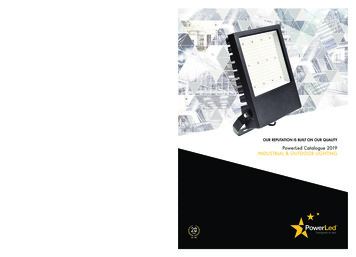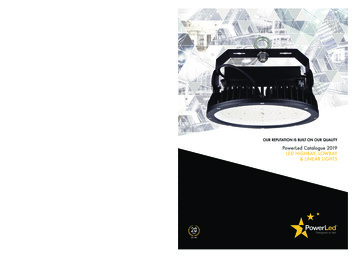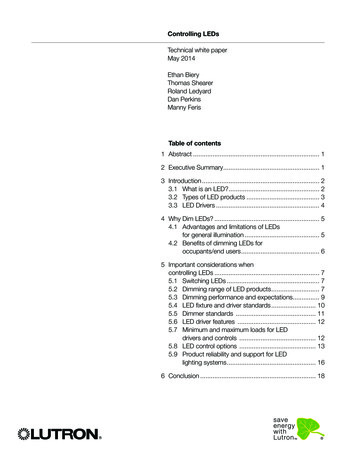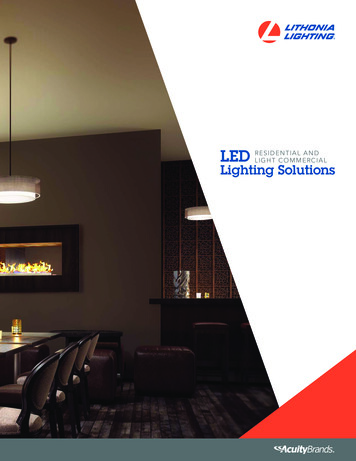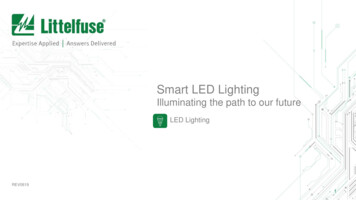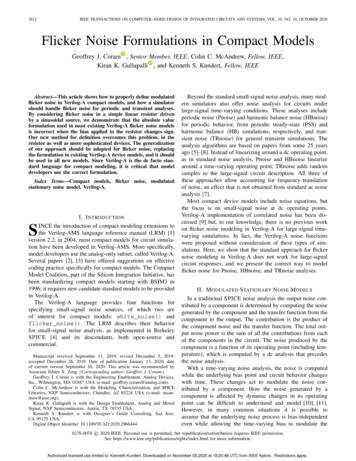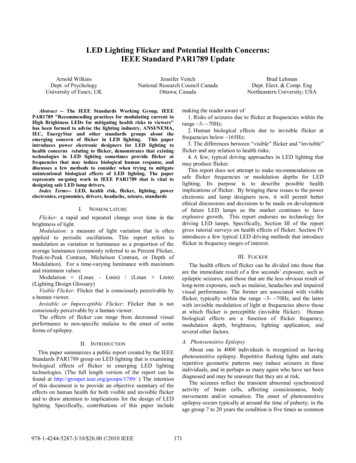
Transcription
LED Lighting Flicker and Potential Health Concerns:IEEE Standard PAR1789 UpdateArnold WilkinsDept. of PsychologyUniversity of Essex; UKJennifer VeitchNational Research Council CanadaOttawa; CanadaAbstract -- The IEEE Standards Working Group, IEEEPAR1789 "Recommending practices for modulating current inHigh Brightness LEDs for mitigating health risks to viewers"has been formed to advise the lighting industry, ANSI/NEMA,IEC, EnergyStar and other standards groups about theemerging concern of flicker in LED lighting. This paperintroduces power electronic designers for LED lighting tohealth concerns relating to flicker, demonstrates that existingtechnologies in LED lighting sometimes provide flicker atfrequencies that may induce biological human response, anddiscusses a few methods to consider when trying to mitigateunintentional biological effects of LED lighting. The paperrepresents on-going work in IEEE PAR1789 that is vital todesigning safe LED lamp drivers.Index Terms-- LED, health risk, flicker, lighting, powerelectronics, ergonomics, drivers, headache, seizure, standardsI. NOMENCLATUREFlicker: a rapid and repeated change over time in thebrightness of light.Modulation: a measure of light variation that is oftenapplied to periodic oscillations. This report refers tomodulation as variation in luminance as a proportion of theaverage luminance (commonly referred to as Percent Flicker,Peak-to-Peak Contrast, Michelson Contrast, or Depth ofModulation). For a time-varying luminance with maximumand minimum values:Modulation (Lmax - Lmin) / (Lmax Lmin)(Lighting Design Glossary)Visible Flicker: Flicker that is consciously perceivable bya human viewer.Invisible or Imperceptible Flicker: Flicker that is notconsciously perceivable by a human viewer.The effects of flicker can range from decreased visualperformance to non-specific malaise to the onset of someforms of epilepsy.II. INTRODUCTIONThis paper summarizes a public report created by the IEEEStandards PAR1789 group on LED lighting that is examiningbiological effects of flicker in emerging LED lightingtechnologies. (The full length version of the report can befound at http://grouper.ieee.org/groups/1789/ ) The intentionof this document is to provide an objective summary of theeffects on human health for both visible and invisible flickerand to draw attention to implications for the design of LEDlighting. Specifically, contributions of this paper include978-1-4244-5287-3/10/ 26.00 2010 IEEEBrad LehmanDept. Elect. & Comp. EngNortheastern University; USAmaking the reader aware of1. Risks of seizures due to flicker at frequencies within therange 3- 70Hz;2. Human biological effects due to invisible flicker atfrequencies below 165Hz;3. The differences between “visible” flicker and “invisible”flicker and any relation to health risks;4. A few, typical driving approaches in LED lighting thatmay produce flicker.This report does not attempt to make recommendations onsafe flicker frequencies or modulation depths for LEDlighting. Its purpose is to describe possible healthimplications of flicker. By bringing these issues to the powerelectronic and lamp designers now, it will permit betterethical discussions and decisions to be made on developmentof future LED lamps as the market continues to haveexplosive growth. This report endorses no technology fordriving LED lamps. Specifically, Section III of the reportgives tutorial surveys on health effects of flicker. Section IVintroduces a few typical LED driving methods that introduceflicker in frequency ranges of interest.III. FLICKERThe health effects of flicker can be divided into those thatare the immediate result of a few seconds’ exposure, such asepileptic seizures, and those that are the less obvious result oflong-term exposure, such as malaise, headaches and impairedvisual performance. The former are associated with visibleflicker, typically within the range 3- 70Hz, and the latterwith invisible modulation of light at frequencies above thoseat which flicker is perceptible (invisible flicker). Humanbiological effects are a function of flicker frequency,modulation depth, brightness, lighting application, andseveral other factors.A. Photosensitive EpilepsyAbout one in 4000 individuals is recognized as havingphotosensitive epilepsy. Repetitive flashing lights and staticrepetitive geometric patterns may induce seizures in theseindividuals, and in perhaps as many again who have not beendiagnosed and may be unaware that they are at risk.The seizures reflect the transient abnormal synchronizedactivity of brain cells, affecting consciousness, bodymovements and/or sensation. The onset of photosensitiveepilepsy occurs typically at around the time of puberty; in theage group 7 to 20 years the condition is five times as common171
as in the general population. Three quarters of patients remainphotosensitive for life (Harding and Jeavons, 1994; Wilkins,1995; Fisher et al. 2005). Many factors [see Fisher et al.,2005 for extensive reference list] may combine to affect thelikelihood of seizures including: Flash Frequency. Any repetitive change in a visualstimulus within the frequency range 3 Hz to 70 Hz, ispotentially a risk and the greatest likelihood of seizures is forfrequencies in the range 15 Hz to 20 Hz, see Fig. 1. Theflashes do not have to be rhythmic. Brightness. Stimulation in the scotopic or low mesopicrange (below about 1 cd/m2) has a low risk and the riskincreases monotonically with log luminance in the highmesopic and photopic range. Contrast with background lighting. Contrasts above10% are potentially a risk. Distance between the viewer and the light source and itslocation which determine Total area of the retina receiving stimulation. Thelikelihood of seizures increases according to therepresentation of the visual field within the visual cortex ofthe brain. The cortical representation of central vision isgreater than that of the visual periphery, and so Location of stimulation within the visual field isimportant: Stimuli presented in central vision pose more of arisk than those that are viewed in the periphery, even thoughflicker in the periphery may be more noticeable. Wavelength of the light. Deep red flicker andalternating red and blue flashes may be particularlyhazardous. Open or closed eyes. Bright flicker can be morehazardous when the eyes are closed, partly because the entireretina is then stimulated. However, if flickering light isprevented from reaching the retina of one eye by placing thepalm of a hand over that eye, the effects of the flicker arevery greatly reduced in most patients.Figure 1. Percentage of patients with photosensitive epilepsy exhibitingepileptiform EEG responses to the flicker from a xenon gas discharge lampshown as a function of flash frequency. After Harding and Jeavons (1994).Figure 2. Escalator stair treadIn addition, a substantial minority of patients (usuallythose who are sensitive to flicker) are sensitive also to spatialpatterns; see Fig. 2 for an example. About one third ofpatients are sensitive to patterns even when there is noflicker, and most are more sensitive to flicker if it is patterned(Harding and Jeavons, 1994; Wilkins, 1995; Fisher et al.,2005; Wilkins et al. 1979). The worst patterns are those ofstripes in which one cycle of the pattern (one pair of stripes)subtends at the eye an angle of about 15 minutes of arc.B. Imperceptible FlickerThe frequency of the alternating current electricity supplyis 60Hz in America and 50Hz in Europe; in Japan, both 50Hzand 60Hz are used in different regions. The circuitry in olderfluorescent lamps with magnetic ballasts operate so as toflash the lamps at twice the supply frequency (100Hz or120Hz). However, as the lamps age, the flashes that occurwith one direction of current may not equal those that occurwith the other direction, and the lamps may emit flicker withcomponents at the frequency of the electricity supply. It hasbeen determined that photosensitive seizures should not occurif fluorescent lamps are operating properly. However, whenthe lamps malfunction giving flicker below 70Hz,electroencephalographic recordings indicate a risk of seizures(Binnie et al., 1979). Nevertheless some photosensitivepatients do complain of normally functioning (older)fluorescent lighting (with magnetic ballasts).Measurements of the electroretinogram have indicated thatmodulation of light in the frequency range 100-160Hz andeven up to 200 Hz is resolved by the human retina althoughthe flicker is too rapid to be seen (Burns et al. 1992, Bermanet al., 1991). In an animal (cat), 100Hz and 120Hzmodulation of light from fluorescent lamps has been shownto cause the phase-locked firing of cells in the lateralgeniculate nucleus of the thalamus, part of the brain withshort neural chains to the superior colliculus, a body thatcontrols eye movements (Eysel and Burandt, 1984). There areseveral studies showing that the characteristics of human eyemovements across text are affected by modulation fromfluorescent lamps and cathode ray tube displays (see work of172
(a) Rectify AC and send to LED stringI LED1LEDLEDLEDLEDLED stringAC 50-60Hz2- 4R13BRIDGE(b) Directly power two LED strings with oppositeAnode/Cathode connectionsI LEDLEDLEDLEDLED(c) Simulation of current through HB LEDs.Luminous intensity is proportional to current,causing lamp to flicker at twice the line frequency(shown periodic every 1/120 sec)AC 50-60HzLEDLEDLEDLEDI LEDR2Or acapacitorFigure 3. Two methods to drive LEDs at twice line frequency: (a) Full bridgerectification, (b) Opposite connected parallel strings, and (c) Current/Luminous Output inWilkins, 1986; Kennedy and Murray, 1991), and two studieshave shown impairment of visual performance in tasksinvolving visual search as a result of flicker from fluorescentlamps (e.g. Jaen et al., 2005). Under double-maskedconditions the 100Hz modulation of light from fluorescentlamps has been shown to double the average incidence ofheadaches in office workers, although this effect isattributable to a minority that is particularly affected (Wilkinset al., 1989).Sensitivity effects due to flicker at frequencies aboveperception have also been observed in normal people withgood vision and health. A substantial decrement in sensitivityto visible flicker at 30 Hz, used as a testing condition, occursin normal observers when there is a prior exposure of only 2minutes duration with flicker frequencies about 20% abovethe observers critical fusion frequency (CFF) (Shady et al.2004).Computer monitors and backlightsWhen making a rapid jerk (saccade), for example whenreading, the eyes move at a velocity of about 180 degrees persecond. As a result, any intermittently lit contour is displacedat a succession of retinal positions during the flight of the eyeand can sometimes be seen as a set of repetitive targets. TheLED rear lamps of motor vehicles can produce such an effect.Some displays on netbook computers have LED backlightsand exhibit significant flicker at 60Hz. Their flicker alsoresults in the perception of multiple images during a saccade.It is possible that this effect is responsible for the knowndisturbance of ocular motor control by high frequency flicker,a disturbance which, in its turn, may be responsible for theknown impairments in visual performance.Modulation depth and the Fourier fundamental.The effects of flicker depend not only on the frequency ofthe flicker but also on the modulation depth. For visibleflicker, the amplitude of the Fourier fundamental predictsflicker fusion (de Lange Dzn, 1961). For imperceptibleflicker the effects of different waveforms have not beenstudied in detail. The peak-trough modulation depth of the100-120Hz flicker from older fluorescent lamps withmagnetic ballasts varies with the component phosphors, someof which exhibit persistence, varying the chromaticity of thelight through its cycle (Wilkins and Clark, 1990). The peaktrough modulation depth known to induce headaches fromfluorescent lighting at 100Hz is about 35% (Wilkins et al.,1989). The IEEE Standards PAR1789 working group isdeveloping new measures/definitions of flicker that rely onFourier series of the flicker. The present definitions formodulation do not distinguish the difference between lowfrequency and high frequency modulation. But forsufficiently high flicker frequencies, there are limited humanbiological effects.C. Summary of Biological EffectsThe obvious biological effects occur: 1) immediately from2) flicker that is visible. The risks include seizures, and lessspecific neurological symptoms including malaise andheadache. Seizures can be triggered by flicker in individualswith no previous history or diagnosis of epilepsy.The less obvious biological effects occur: 1) from flickerthat is invisible 2) after exposure of several minutes. Invisibleflicker health effects have been reported to include headachesand eye-strain.The table in the Appendix summarizes and categorizes thetypes of flicker and the biological effects they cause.173
D. A Few General Implications for PracticeVisual flicker is an undesirable attribute of any lightingsystem. The Appendix Table summarizes research suggestingthat, for both visible and invisible flicker (in the mentionedfrequency ranges), there may be a special at-risk populationfor which flicker is more than just annoying and can be apotential health hazard. Any hazard will, however, dependon modulation depth, ergonomics, flicker parameters andtheir relation to perception and the ability tomeasure/determine the influence of these parameters withhuman diagnostics. These topics are beyond the scope of thispaper and will be covered in future IEEE PAR1789documents. However, it is possible to make generalcomments about the research cited in the Appendix Table:1. Frequency. Normally functioning fluorescent lightingcontrolled by magnetic ballasts has been associated withheadaches due to the flicker produced. LEDs driven so thatthey flicker at a frequency twice that of the AC supply mayhave a depth of modulation greater than that from mostfluorescent lamps. The effects of the flicker are thereforelikely to be more pronounced in these cases.2. Field of view. Point sources of light are less likely toinduce seizures and headaches than a diffuse source of lightthat covers most of a person’s field of vision. Flicker fromLEDs used for general lighting is therefore more likely to bea health hazard than that from LEDs used in instrumentpanels.3. Visual task. The invisible flicker described in theAppendix Table is more likely to cause problems when thevisual task demands precise positioning of the eyes, as whenreading.4. Spatial distribution of point sources of light. Spatialarrays of continuously illuminated point sources of light havethe potential to induce seizures in patients with photosensitiveepilepsy when the field of view is large and when the arraysprovide a spatial frequency close to 3 cycles/degree (e.g.large LED public display boards viewed from closeproximity).IV. TYPICAL LED DRIVING METHODS IN LOW FLICKERFREQUENCY RANGEThere are several common methods that are used to driveLEDs that can operate with frequency of modulation in theranges discussed in the above table (below 120Hz, includingfrequencies in the vicinity of 15Hz.)For example,commercially available LED lamps have been reported (Randet al., 2007; Rand, 2005) to malfunction and produce visualflicker in the 15Hz range when connected to a conventionalresidential dimmer.Below, we present only a few driving approaches thatmodulate in frequency ranges from zero to 120Hz. The list isnot exhaustive, and the discussions are only meant todemonstrate typical driving LED currents with frequencies inthis range.A. LED Driving Current Frequencies in Range: 100Hz–120Hz(1) Full Wave Rectifier Connected to LED StringIn this approach, the AC input source is sent into a fullwave rectifier, causing the (approximate) absolute value ofthe input voltage to be sent to the load. In this case, thecurrent through the LEDs has a waveform shape similar to ascaled absolute value of a sine wave. That is, the rectifiedsine wave may be of the V p sin(ωt ) form, where Vp isthe amplitude of the sinewave and ω is theangular frequency in radians ω 2*π*f. In this case, the LEDcurrent is of similar shape, as Fig. 3 shows. In a firstapproximation, the LED current is equal to a scaled rectifiedvoltage, with the additional deadtime (zero current) caused bythe LED bias voltage. Thus, when properly functioning, thedirect full wave rectifier driving approach modulates theLEDs at twice the line frequency, which in North Americaleads to 120Hz modulation and in Europe leads to 100 Hzmodulation. As Fig. 3(a) shows, often a resistor is added inseries with the LED string for current limiting protection.(2) Directly Drive Two Parallel LED Strings withOpposite Anode/Cathode ConnectionsA second LED driving method that doubles line frequencyis shown in Fig. 3(b). Two strings of LEDs are powered inparallel, with anode of one paralleled string connected to thecathode of the other parallel string. When the AC line voltageis positive, energy drives one of the LED strings. When theAC line voltage is negative, the other paralleled LED string isdriven. At most, one of the LED strings has current throughit. The net effect is that the effective LED driving current ismodulating at 120 Hz in North America or 100 Hz in Europe.Thus, for both driving methods illustrated in Fig. 3, theLED current modulates at twice the line frequency. Since theintensity of the LEDs is (ideally) proportional to the currentthrough the LEDs, this causes the LEDs to flicker atfrequency equal to twice the AC line frequency, i.e.100Hz 120Hz. There are many variations of the approach inFig. 3 that are not shown here.(3) Simple Dimming Pulse Width Modulated (PWM)CircuitsIt is common to dim LEDs by pulsing the current throughthem intentionally.The luminous intensity of the LED can beadjusted by varying the length of time that the LED current isHigh or Low,. Thus, PWM dimming circuits may be designedto operate at any frequency, whether the input is DC or AC.(It should be noted that it is not uncommon for LED driversusing AC residential phase modulated dimmer circuits toattempt to “emulate” PWM type signals with frequency120Hz. That is, when the AC dimmer shuts off, no current issent to the LEDs.)It should be mentioned that there are alternativeapproaches to dimming, such as amplitude dimming, inwhich the current through the LED is continuous and not174
pulsing. By reducing the value of this continuous current(amplitude), the brightness is dimmed. This approach doesnot use flicker to adjust brightness and therefore, should notinduce flicker related health risks.(4) Power Factor Correction CircuitryEven when sophisticated high frequency switching powersupplies with power factor correction circuits are used todrive LEDs from AC mains, there is commonly a frequencycomponent in the current (and luminous intensity) of theLEDs at twice the line frequency. Depending on the design ofthe circuitry, the harmonic content of this flicker may varyfrom being small and unnoticeable to being significant inmagnitude.Some LED lamps and their associated drivers may notperform properly with residential phase modulated dimmers.Often on the LED bulb application notes or on the lamp’smanufacturer web sites there are warnings to the user thattheir bulbs may not work properly when used with residentialdimmer switches. Rand’s work (Rand et al., 2007; Rand,2005) explains the causes of these failures and shows that lowfrequency flicker may occur.B. LED Driving Current Frequencies in Range: 3Hz 70Hz(1) Failures in rectification or LED strings: 50Hz 60 HzModulationIn either of the two methods of Fig. 3, there is risk offailure that can cause LED current modulation at AC linefrequency, thereby entering the range of frequencies that mayinduce photosensitive epilepsy. For example, if one of thelegs of the full wave rectifier bridge fails, then it is commonthat the leg becomes an open circuit. Open circuits preventcurrent flow, and therefore, the LED modulation frequencymay change. This single diode failure in the rectifier willcause the output voltage for the full wave rectifier to becomethe input voltage for half the AC line cycle, and then 0 voltsfor the remaining half line cycle. This means that if the ACMains line frequency is f and the period is T 1/f, then nonzero voltage is applied to the LEDs for 0.5*T seconds andthen is zero for the next 0.5*T seconds, causing the LEDcurrent to modulate at line frequency.Similarly, when the two strings of LEDs are connected inparallel with opposite anodes and cathodes in each string, afailure in one string of the LEDs may cause an open circuit tooccur in that string. The net effect is the same as before: thecurrent is modulating at line frequency, i.e. 50Hz 60Hz.This low frequency driving current leads to brightness flickerin the LEDs at 50Hz 60Hz, since the current in the LEDs isproportional to their intensity. This is in a range offrequencies that are at risk of causing photosensitive epilepsy.(2) Residential Dimmer Switches Can Cause LowFrequency Flicker ( 3Hz – 70Hz)Residential dimmers for incandescent bulbs primarilyutilize phase modulating dimming through triac switches tocontrol the power sent to the bulb. These dimmers control theRMS voltage applied to the bulb by suppressing part of theAC line voltage using a triac. The effect is a chopped sinewave as shown in Fig.4. Thus, as the dimmer switch ismanually adjusted, the value of the off-time, α (often referredto as the phase delay) changes. As α is increased in Fig. 4,less power goes to the incandescent bulb and brightness isreducedDimmer VoltageαFigure 4. Residential dimmer and its output voltage sent tothe driver (Rand et al., 2007).Fig. 5 illustrates how one type of commercially availableLED lamp flickers in the noticeable visual range whenconnected to a dimmer switch. The particular lamp involvedhas a common LED driver configuration (further discussedbelow) of a full bridge rectifier with capacitor filter withintheir Edison socket, described in more detail by Rand et al.,2007; 2005). The results presented in the figure may betypical of similar driving configurations. The circuit willcontinuously peak charge the filter capacitor to the peakvoltage of the input waveform, i.e. 169Vdc for standard120Vac line voltage. This high level DC voltage may then befed into a large string of LEDs in series. For example, sometypical lamps may have parallel strings of many Red, Blue,Green LEDs, in series attached through a current limitingresistor to the high level DC voltage. The particular lamptested utilized a combination of 64 Red, Green and BlueLEDs to produce white light.175
Figure 5. Commercial LED lamp flickers at 3.15Hz whenconnected to typical residential dimmer switch.The experimental data in Fig. 5 represents the voltage of aphoto-sensor placed directly underneath the LED lamp.Specifically, a photoresistor circuit is used to generate avoltage proportional to the light intensity shining on it. As theexperimental voltage shows, the bulb malfunctions whenconnected to (phase modulated) residential dimmer switch. Itproduces a noticeable visual flicker. In particular, the flickervaries between around 3.0Hz and 3.3Hz, with average overmany cycles of 3.153Hz. This frequency is in the range thathas been shown to be a risk for causing photosensitiveepileptic seizures.The flicker illustrated in Fig. 5 is typical of a few LEDlamps on the market when connected to a dimmer. However,the precise flicker frequency is hard to predict, as it mayeither be higher or lower depending on various factors suchas number of lamps on the dimmer, position of the dimmerswitch (the value of desired off-time α), and/or internalcharacteristics of the lamp. However, as the experimentaloscilloscope plot shows, the flicker frequency may be in therange that induces photosensitive seizures.The reasons that the dimmer switch may fail whenconnected to LED lamp bulbs are given in (Rand et al., 2007;2005).(3) Uneven Brightness in Different LED Strings WhenConnected as in Fig. 3(b)- With Strings Having OppositeAnode/Cathode ConnectionsConsider the circuit in Fig. 3(b). Notice that each LEDmust have the same dynamic characteristics (forward voltageand dynamic resistance) in order for the current to beperfectly balanced in each alternating illuminated string. Iffor some reason this does not occur (aging, temperaturegradients, poor design), then the current through the stringswill not be identical each cycle.Figure 6. Unbalanced LED Current in Each String ofLEDs Using Driving Method in Fig. 3(b). The unbalanceddriving will cause uneven luminous output in the lamp andlow frequency flicker.For example, suppose over time, aging causes degradationof one of the two strings in Fig. 3(b) such that its stringresistance increases by 50%. This could also be caused byimproper design of each string in Fig. 3(b) so that the currentin each string is not balanced. This is quite possible sinceLEDs are binned by different voltages, and further, eachstring may be composed of different color LEDs that havedifferent nominal voltage drops for the same current. Then,the effective LED current through the bulb will look as inFig.6.For example, the effective DC LED current in thenumerical simulation of Fig. 6 has average value of around233mA. However, the Fourier component at 60 Hz (takingFFT) is 80mA and the Fourier component at 120Hz is nearly240mA. Thus, in this example the low frequency componentof 60Hz represents over 33% of the DC component, while the120 Hz component represents 100% of the DC current.Higher frequency components of the LED current in theabove figure are also present in multiples of 60Hz. However,the typical analysis above indicates that LED lamps maydemonstrate flicker frequency at line frequency, similar toolder fluorescent lamps (previously discussed) that agedunevenly: the flashes/brightness with one direction of linecurrent may not equal those that occur in the other direction.The above example also illustrates that it is possible forflicker in a lamp to have harmonics with multiple lowfrequency components, here at both 60Hz and 120Hz.V. CONCLUSIONSThe purpose of this paper is to make lamp and powerelectronic designers aware of biological effects of flicker andto introduce the reader to a few LED driving methods thatwill have flicker. The LED driving approaches described inthis paper are not exhaustive and are only meant to introducethe reader to a few common approaches. Otherapproaches/applications of LED lighting that may also haveflicker include, but are not limited to, pulse amplitudemodulation driving, triangle wave currents through LEDs,176
using LED flicker for wireless communication (see IEEEStandard 802), beat frequencies created through theinteraction of different lamp flicker frequencies, etc.This paper assigns no health risk to the biological effectsof flicker in the various LED lamps. The hope is that bydiscussing the issue of flicker within the power electroniccommunity, it will be possible to decide as a communitywhether or not standards or recommended practices arenecessary. We do not attempt to do so here. However, we dooffer simple suggestions as to what should be consideredwhen designing lamps, such as flicker frequency, angle ofviewing, task being performed, spatial distribution, ACdimmer flicker, etc. Further, it is not difficult to create shutdown or other safety prevention circuits that preventflickering in the 3Hz-70Hz range when the lamp is in failuremode. This is the flicker range that has risk of photosensitiveepilepsy for small minority of the population.ACKNOWLEDGMENTThis paper was assembled with input from many membersof IEEE Standards PAR1789 who at the time of writingconsisted of (including observers):Maurizio Acosta, Ian Ashdown, Rolf Bergman, SamBerman, Anindita Bhattacharya, Subramanyam Chamarti,Clint Chaplin, Yvonne de Kort, Montu Doshi, KevinDowling, John Halliwell, Mark Halpin, Steve Hayes, ChrisHorton, Wijnand IJsselsteijn, Michael Jennings, JiaoJianzhong, David Keeser, Faisal Khan, Thorbjorn Laike,Brad Lehman, Ihor Lys, Theron Makley, Naomi Miller,Lesley Murawski, Brandon Oakes, Yoshi Ohno, StevePaolini, Radu Pitigoi Aron, Michael Poplawski, Conor Quin,Eric Richman, Anatoly Shteynberg, Michael Shur, RogerShuttleworth, DavidSliney, Jennifer Veitch, JoachimWalewski, Arnold Wilkins, Howard Wolfman, Wei Yan,Regan Zane.REFERENCESPrimary References for This Report are below. (Please refer to the ouper.ieee.org/groups/1789/ that were also used. The web site willcontinuously be updated.)Berman, S.M., Greenhouse, D.S., Bailey, I.L., Clear, R.D., and Raasch,T.W. (1991) Human electroretinogram responses to video displays,fluorescent lighting, and other high frequency sources. Optom Vis Sci.,68(8),645-62.Binnie, C.D., de Korte, R.A., and Wisman, T. (1979) Fluorescentlighting and epilepsy. Epilepsia,20,725-7.Burns, S.A., Elsner, A.E., and Kreitz, M.R. (1992) Analysis ofnonlinearities in the flicker ERG. Optom Vis Sci.,69(2), 95-105.de Lange Dzn, H. (1961) Eye's Response at Flicker Fusion to SquareWave Modulation of a Test Field Surrounded by a Large Steady Field ofEqual Mean Luminance. Journal of the Optical Society of America, 51(4),415.Evans J.E., Cuthill I.C., and Bennett A.T.D. (2006) Animal Behaviour,72(2),393-400.Eysel, U.T., Burandt, U. (1984) Fluorescent tube light evokes flickerresponses in visual neurons. Vision Res., 24(9),943-8.Fisher, R., Harding, G.F.A., Erba, G., Barkley, G.L., and Wilkins, A,J.(2005) Photic- and pattern-induced seizures: a review for the EpilepsyFoundation of America Working Group. Epilepsia, erlays/2005-168.pdfFunatsuka, M., Fujita, M., Shirakawa, S., Oguni, H., and Osa
technologies in LED lighting sometimes provide flicker at frequencies that may induce biological human response, and discusses a few methods to consider when trying to mitigate unintentional biological effects of LED lighting. The paper represents on-going work in IEEE PAR1789 that is v


